On to New Zealand
Author: Shirlz
Vava’u, Tonga
31 October 2019
I was ready to go. A bad chest cold that had been bothering me had cleared up, but now a strong southerly wind was blowing, not ideal. I decided to wait another day and went for a last walk on the wild and windy side of the Island. Sheri came round in the evening with a bag of surprises to be opened at sea. What a lovely thought.
Friday, 1 November 2019
The forecast was too good to miss so I decided to leave despite the fact that it is Friday, normally considered a taboo day for starting a voyage. The dateline takes an artificial kink around Tonga, so I felt justified in putting superstition aside.
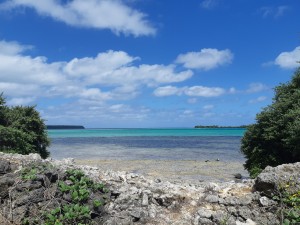
Last view of my little beach
A slightly slow start with not enough wind to sail off the mooring had me motoring for a short while. The engine didn’t sound too happy and died after a few minutes, but we were underway at last and I decided to keep going. I suspected that the problem was just due to an airbubble caused by a recent filter change. We had a lovely sail down through the maze of little islands and soon enough we were in the open sea. I started to feel a little queasy. I had spent too long in flat, protected water.
By the evening I was feeling better and we were sailing smoothly along with 2 reefs in the sail doing a comfortable 4 knots. I had a sundowner beer followed by a some lentils and rice for dinner.
The restored Navik wind-vane was working well with a bit of help from the famous green bungee to compensate for weather helm. I was very glad that I had moved the table over to the port side so that I could use the starboard bunk. With the wind from the east It looks like we could be spending a lot of time on a port tack. I unearthed a derelict old cell phone which has a good loud alarm and used it to wake me every twenty minutes.
At about 2am I spotted the lights of a ship about 2 or 3 miles off, heading north. No AIS warning. We passed safely.
2 November 2019
A reasonably comfortable night, sleeping well between the 20 minute wake-ups.
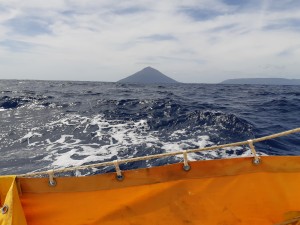
Kao with Tofua in the background
In the morning the volcanic island of Kao rose steeply out of the haze ahead. Quite a surprise. We passed safely about 5 miles off. In the evening, Tofua, its flatter sister was still in sight to port. The wind had dropped a little so I was using the full sail. Before dark I dropped one panel.
3 November 2019
Wind a lot stronger and heading us. I hastily reefed down to 3 panels. Now the area of volcanic activity which I was hoping to pass east of lay directly in our path. I eased off on the sheets to pass more comfortably to the west. The sea now very rough and we were just plugging along at 1 to 2 knots, but laying a reasonable course. I had been reading about volcanic islands suddenly erupting about here and was anxious to get clear of the area. The sea seemed very bumpy. Maybe something was brewing down in the depths. No choice but to carry on.
4th November 2019
The day started out with a squall. Grey skies, wind up and down. After lunch the sun came out. Things always look better when the sky and sea are blue.
5pm and 1000 miles to go.
5 November 2019
A big ship passed one mile off during the night. I first spotted a faint glimmer of lights on the horizon. A struggle to see with the binoculars. Switched on the AIS and waited for it to get a GPS signal. Still nothing. Now I can definitely see its a ship and coming our way. Get out the hand held compass and take a bearing. Ahh..the AIS has woken up at last, loud alarm to warn that the closest point of approach will be 1.5 miles. A bit close for comfort but safe enough. I sat out in the moonlit cockpit and waited for it to pass. Then back to my bunk after first checking that the battery had plenty of life and deciding to leave the AIS on.
6 November 2019
After an easy night with a beautiful half moon and no more ships we had an idyllic day on a smooth sea doing a steady 4 knots, wind just abaft the beam.
7 November 2019
Wind really picked up this morning from the NE. Now racing along under just 2 panels.
8 November 2019
Fast sailing all night. We’re out of the tropics now and it’s starting to get chilly. The Navik still performing perfectly. What a relief.
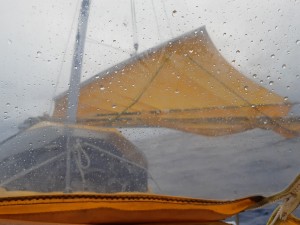
racing along with just one panel
I noticed that one of the lashings at the end of a lower reefed batten had come adrift. Hove-to to fix it. Must have happened when the top sheet span got caught under the reefed bundle.
Moving fast.
Noon position showed our best days run so far. Just over 100 nm.
Later down to the top panel only. A bit less wild.
9 November, 2019
Wind still F6. Making good progress but not very comfortable. Crossed the 180 meridian so now we are East instead of West.
The wind picked up to F7 later with scary streaks of foam on the water and rather big waves. I decided to gybe and head more to the west where the weather fax indicated better conditions.
Just before dark I hove-to as it was getting really rough. Too much water on deck and in the cockpit. The odd one reaching the chart table. Massive waves.
After about 2 hours of drifting northwards I packed it in, decided it wasn’t really all that bad and started sailing again.
10 November, 2019
Made it through the night. Still on a WSW course. A bit of rain this morning and sun occasionally breaking through.
No dolphins, flying fish or birds. A lonely sea.
11 November, 2019
Working slowly to windward.
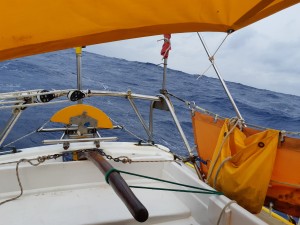
Navik working well with help from the green bungee
A bit of a rainy patch this morning but now lovely sunshine. I had been taking a lot of care not to let myself get wet when going outside, always putting on a waterproof jacket and taking off my long pants. As the sun came out, I became careless and of course, one of those little rogue waves leapt into the cockpit just as I was adjusting the Navik and soaked my warm jersey. I had to scratch around to find something else warm to wear.
Saw an albatross.
12 November 2019
Still very windy and rough this morning. During the night the Navik vane got blown about 30 deg out of alignment which set us rather off course. Too far east. Not good. Well, that’s another thing I must remember to check hourly. Now back on track but what a waste.
13 November 2019
Spent many hours in the cockpit last night trying to get the sail working properly on the port tack. Adjustment of the sheet seems critical when close-hauled. The wind had gone light and the sea was still lumpy which didn’t help. It was pleasant enough, with a nearly full moon. I had put on my heavy duty off shore gear to keep warm. No more bare arse and light jacket. The duvet is on the bunk and it still feels chilly at night. You know you’ve left the tropics when the coconut oil solidifies.
We eventually settled on a reasonably steady course, jogging along at about 2 knots, clawing our way westward.
This morning I noticed that the parrel on the second batten from the top had almost completely chafed through. All those days of running downwind, deeply reefed. I found a suitable length of line to replace it, hove-to and we were soon on our way again. A beautiful day. I made some sweetcorn fritters for breakfast as the muesli and fruit juice was becoming boring.
A pair of Kermadec petrels came over to check us out. Yesterday I spotted an albatross. Too far off for exact identification but thrilling to see.
After the noon position-taking ritual I tacked to work back to the rhumb line. Exceedingly slow and frustrating. The sail definitely works better on the port tack, but we were heading too far east and something had to be done. We hung in there, determinedly. Reading Pratchett.
14 November 2019
We had been going along quite nicely and things were looking up. I was getting a few hours sleep, when I was rudely awoken by bumpy seas and loud thunder. OK, a cold front had been shown on the weather fax. This must be it. I lowered a panel, although the wind didn’t seem very strong. Heavy rain. As the squall passed, the wind direction changed and now was heading us again. End of comfortable progress. I tried for the best possible course and went back to bed till morning.
15 November 2019
When the sun came up the wind had died completely. Time to get the engine going. What a pain. It ran for about 20 minutes and then totally died. Oh dear. Not too difficult to check things out on a nice flat sea and it seemed that the problem must be fuel starvation. Something wrong with that filter I’d put on before leaving. Luckily I had another spare and it was easily installed. We were on our way again.
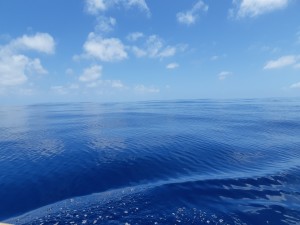
No wind
I dressed up warmly and sat in the cockpit hand steering. Slow progress. With much careful adjustment of bungees, engine revs, chain position on tiller and angle of wind vane, I managed to get the Navik to hold us reasonably well on track. Not good enough to just leave and go below, but no longer necessary to have a hand constantly on the tiller. Progress indeed.
I missed the 1pm weather fax but then noticed fine high cirrus in the sky, which doesn’t normally bode well. I managed to pick up a clear chart at 3pm which gives the 72hour forecast. No storms looming. No wind either. Big high pressure system. It would be a doddle if the electric autopilot was working and I had a few more litres of diesel.
Some beautiful petrels soared and skimmed nearby. Maybe our wake kicks up little edible creatures.
Switched off the engine at midnight to get a few hours sleep.
16 November, 2019
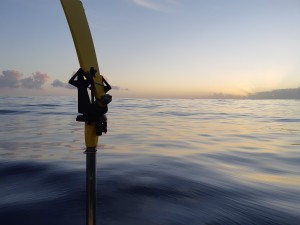
Motoring on a flat sea
Sea flat calm. Not a breath of wind which means the Navik is no use at all, but the bungee is coping well enough to hold us on course with the engine running.
It was warm and sunny and I grabbed the opportunity to have a rather overdue shower in the cockpit using the garden sprayer. Feels good to be clean and fresh again.
17 November 2019
A really good day. After a decent night’s sleep I woke to find there was enough wind to really start sailing again. A smooth 1-2 knots and as the wind gradually freshened the Navik was able to take over the steering. What bliss after 26 hours of noisy motoring.
And then a pack of about 30 dolphins appeared on the scene, circling and making multiple passes. I did my usual demented singing thing which they seem to appreciate. Before leaving, a big one surfaced right near the boat and gave me a friendly, if slightly curious, look in the eye.
The weather is sunny and warm and I can sit in the cockpit without getting drenched by every passing wave. Only 140 miles to go now, and the 48hr forecast looks fair.
18 November, 2019
The wind picked up quite strongly overnight and I had to reef to 3 panels. Now moving at 4-5 knots on a steady course.
By noon we had covered just over 100 miles. Amazing. It started to look as though the end was in sight.
It had become quite hazy with visibility limited to about 1 mile. During the day I don’t have the AIS on as I spend a lot of time looking out, but because we were almost there, I was busy filling in the multitude of forms needed to clear in and hadn’t had a look out for some time. When I belatedly stuck my head out a massive container ship was just looming out of the murk. Far too close for comfort and on an obvious collision course. As they say, ‘the show ain’t over till…’ I quickly switched on the AIS to get an accurate assessment and tried calling them on the radio. But couldn’t waste too much time as it was obvious that I would have to get out of the way, and smartly. With the sail far out and deeply reefed, I was worried about gybing and causing a fan-up. But I would have to turn more downwind to pass safely. My luck held and although we were forced to sail by the lee the sail stayed firmly in place. What a wonderful rig. The ship passed with half a mile to spare and we were soon back on course again.
Just before dark a black squall loomed over us. Thunder and lightning. Wind going crazy. When it settled down about 2 hours later, the best course I could manage was hard on the wind and about 20deg W of the course. Still nearly 40 miles to go. Looks like we wont get there today.
19th November, 2019
The wind held steady all night and we made slow progress. I managed to get a few hours sleep in 20 minute snatches. At about 5am it was just light enough to see ahead and to my amazement the land was visible. Still about 8 miles off but the timing was good as now we were reasonably sure of arriving in daylight. I managed to light the primus and made a mug of coffee.
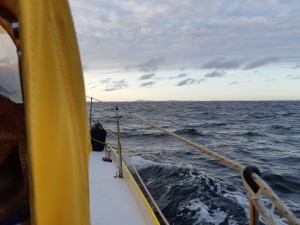
Land just visible on the horizon
Then the wind dropped again and I was able to shake out all those reefs and soon decided that the engine would be a good idea. As the day brightened, a welcoming committee of three dolphins and two gannets came to greet us. Just perfect. A big catamaran approached from astern and soon passed us. Also on the way in. A bit later there was another mega yacht motor sailing past.
The land was still a grey silhouette on the horizon, but as we got closer colours started to fill in. A very interesting scattering of rocky islands.
Soon enough I was in the thick of ferries, small sailing boats, a para-sailor, a plethora of small motor boats out fishing. It was a struggle to stay awake and keep my wits about me. I was delighted by a flotilla of small penguins who hurried to get underwater and swim rapidly away as we approached. At last, there was the customs dock at Opua. I managed to tie up alongside and the officials took over. The bottom of the hull was checked for marine growth by using a video camera on a long stick. I held my breath, worried that they might find the odd determined barnacle, but we passed the test. Passport stamped, contents of lockers inspected and we were free to go. Whew.
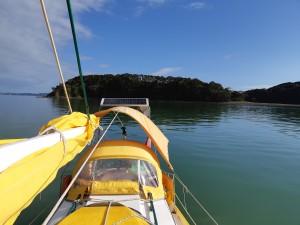
Safely anchored, Bay of Islands, New Zealand
I moved around to a quiet little anchorage for the night and cracked the bottle of bubbly.












November 22nd, 2019 at 12:31
Great to hear you’re in and safe even if your tales of AIS were a tad alarming!
Hugs from us 3
mbt
November 23rd, 2019 at 06:50
An inspiring read, as always, Shirley. Your word portraits are so vivid,evocative and instructive. You are not only one of the great small boat voyagers but a first-class sea scribe as well. This entry is a masterclass in singlehanded, junk rigged,small-boat passagaemaking.
November 24th, 2019 at 12:37
Congrats Shirley,
You really are amazing and very inspiring… just about everyone searching for bigger boats and there you are solo across the Pacific in the loveliest old Vertue.. junk rigged to boot!
What I’d love to ask you, since you are someone who knows well both bermudan rig and junk, is did it take you some time to adapt to the somewhat untidy* look of a junk sail when deep reefed? This is not meant in the slighest bit derogatory as I am a fan of junk but little experience of it. I sort of feel that once deep reefed and sorted the bermudan rig ‘feels’ more tidily snugged down and under control. I agree it is massively more hectic getting bermudan snugged down and that junk is easily dropped to a single or couple of panels with virtually no stress or antics. But (being inexperienced in junk) I feel slightly uneasy at the apparently slightly wild appearance of the reefed stack/bundle and straining final panel. Is it that the ease of reefing junk far outweighs the taut snugness of a deep reefed bermudan (or gaff)and one values that ease above a slightly more comfortable sail shape and set? Or does experience show that the deep reefed junk is just as snug, handy and reassuring as the deep reefed bermudan? Earnestly and honestly seeking your experience and comment.
*(Please no junkies consider ANY negativity implied!! I agree ‘untidy’ may not be the best word but hope you will take it in its lightest sense!) Cheers!
Hope Bay of Islands is treating all your senses warmly.
November 24th, 2019 at 15:33
Now you come to mention it, I suppose the deeply reefed sail does look a little untidy.it has never seemed to be a problem.
When reefing, it helps to come up into the wind a bit so that the lowered panels stack more neatly into the lazy Jacks. Careful tensioning of the yard hauling parrel also makes a difference.
I have never resorted to tying a safety line around the reefed bundle, but if you are really worried this could be done
November 28th, 2019 at 12:24
Yay!
November 30th, 2019 at 09:36
Hi Shirlz m long time no read , my fault…
Been busy…
Lovely to catch up ?
As always , a treat , and happy now you are across the other pond.
I am looking to buy a boat , probably in your old stomping grounds , but possible in SA. Watch this space ??
Looking forward to your next update
Your friend …
Kris
December 2nd, 2019 at 16:13
Legend! As you well know I know nothing of sailing – but so proud of you my big sister!??
March 3rd, 2020 at 17:02
Hi Shirley,
your blog is truly inspiring.
I would really appreciate your opinion on the Reddish sailplan as I’m currently converting my 30ft bermudan rigged sloop to junk rig for ocean cruising, and need to choose between the Reddish and Hasler/McLeod sail shapes before I start lofting and cutting my sail fabric. Specifically, do you find the curved leech of the Reddish sail causes problems with the sheetlets getting hung up on the batten ends when tacking?
I’m a JRA member and have Vincent Reddish’s articles so I’ve been able to draw up a suitable sailplan. I love the look of the fanned sail, and the simplicity of straight (non hinged) battens. I don’t want cambered panels and am wary of hinged battens for blue water sailing.
Your experience would be greatly appreciated.
Jerry
March 6th, 2020 at 04:07
Hi Jerry,
Well, yes, the sheetlets do sometimes get caught on the batten ends when tacking and it is something I’ve just learned to live with. It just needs coming up into the wind to shake things out. If short tacking I would normally just leave a caught sheetlet till the next tack frees it. I only bother to sort it out if I expect to stay on the same tack for some time.
Good luck with your sail making!
March 7th, 2020 at 13:52
Thanks for that Shirley.
I was planning to end my battens flush with the leech and bolted to the sail with dome headed stainless machine screws and nyloc nuts, with lashings only used at the luff end for tensioning the sail. Hopefully that would avoid chafe and some of the sheetlet tangles, although it sounds like it’s largely a non issue anyway.
Have you tried separate sheets for the top and bottom halves of your sail? Vincent Reddish changed from a single mainsheet to this arrangement to allow control of twist and consequently, camber, with plenty of twist for light airs, and flattened right off for when reefed down.
Jerry.